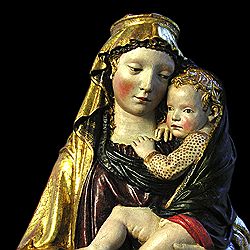The Rebirth of Terracotta
The rebirth of terracotta, widely used in antiquity, which had disappeared during the Middle Ages, took place in the early 15th century. Recently the critics have underlined the central role played by this technique as part of the overall 15th-century research which would result in the revival of all the arts.
In Florence, in the workshop commissioned with the making of the North Door of the Baptistery, overseen by Lorenzo Ghiberti, (1403-1424) and a veritable breeding ground for new ideas and techniques, wax and clay modelling were practiced with great devotion.
It is to Brunelleschi and Donatello, two innovators par excellence, that we owe the first sculptures in terracotta. The two artists confidently used different materials, attributing them equal dignity. They were assisted by a group of young artists (Michele da Firenze, Nanni di Bartolo, Michelozzo, and Luca della Robbia) who, starting from their masters’ achievements, created works in terracotta of great importance. In the first section of the exhibition, the
Madonna and Child from the Bishop’s Palace in Fiesole, here attributed to Brunelleschi, and the Bardini
Madonna and Child by Donatello, entertain a busy and fruitful dialogue made of subtle echoes and similarities with the Bargello
Madonna by Michele da Firenze, with the
Saint Anthony the Abbot by Nanni di Bartolo, with the
Santa Lucia by Michelozzo and, above all, with the
Madonna and Child from the Church of Santa Felicita by Luca della Robbia. The latter was another leading figure in the use of this technique as well as a true experimenter being the inventor of glazed terracotta, that is clay works coated with ceramic glaze.
< | >
